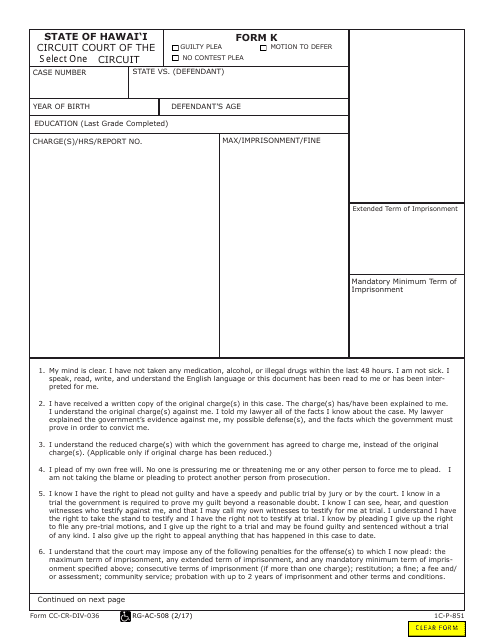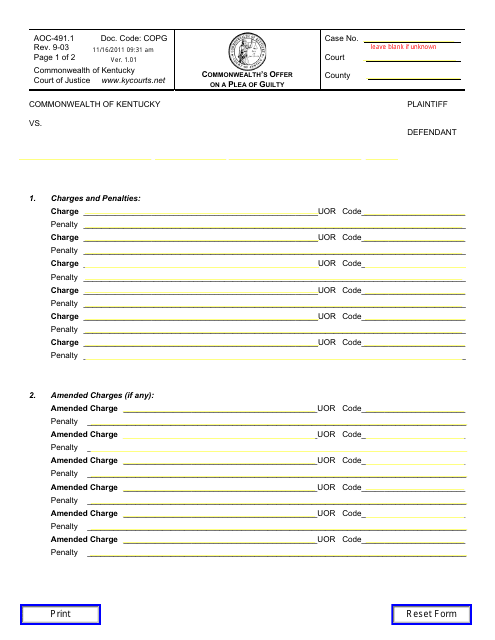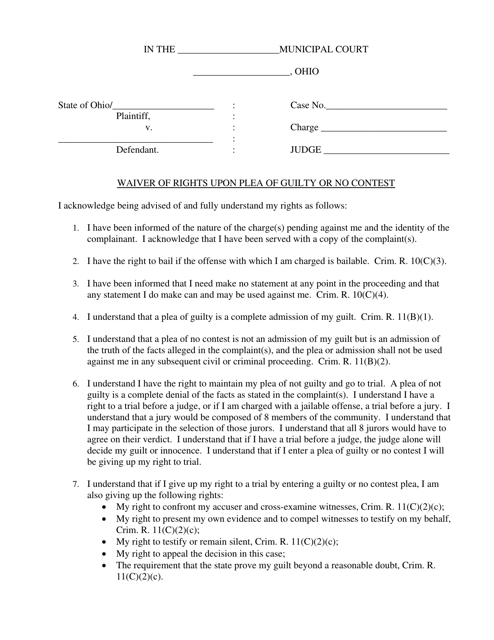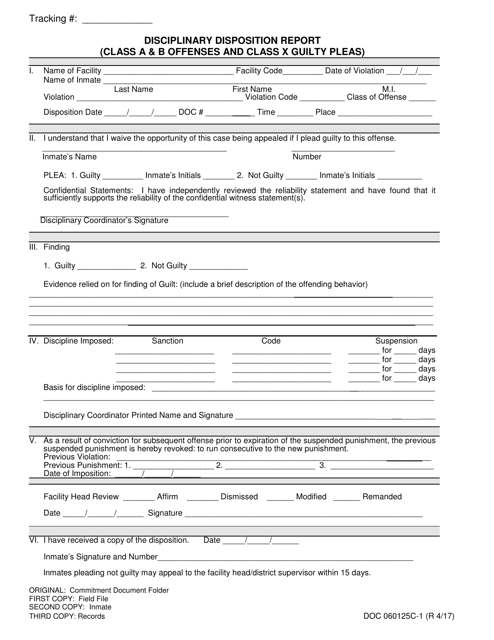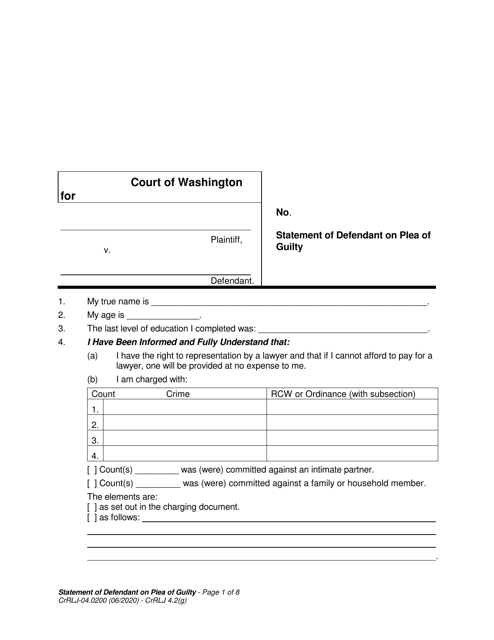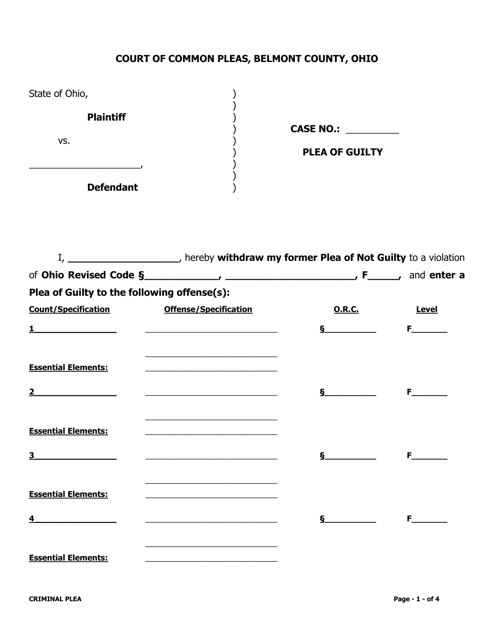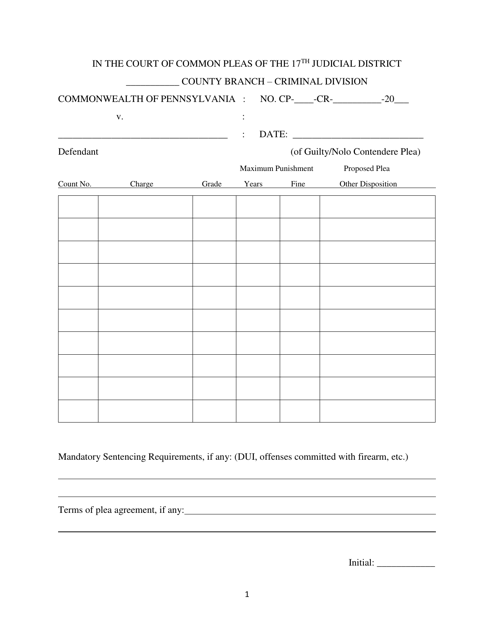Guilty Plea Templates
A Guilty Plea is a legal document that is used in criminal cases when a defendant admits their guilt and accepts responsibility for the charges against them. This document serves as a formal declaration of the defendant's choice to plead guilty, waiving certain rights and allowing the court to proceed with the case.
Also referred to as Guilty Pleas or Guilty Plea Forms, these documents are essential in the criminal justice system as they provide a clear record of the defendant's decision. By signing the Guilty Plea document, the defendant is acknowledging their wrongdoing and consenting to the consequences outlined by the law.
In jurisdictions such as Ohio, Alabama, Pennsylvania, Wisconsin, and Washington, specific forms have been developed to ensure that the guilty plea process is properly documented and understood by all parties involved. These forms, such as the Waiver of Rights Upon Plea of Guilty or No Contest, Form C-74 Plea of Guilty/Waiver of Rights, Form MDJS408B Guilty Plea Colloquy (English/Chinese Simplified), Form CR-227 Plea Questionnaire/Waiver of Rights, and Form JuCR7.7 Statement on Plea of Guilty, streamline the process by covering essential information, such as the defendant's understanding of their rights, potential consequences, and any additional agreements made with the prosecution.
Taking the step to plead guilty is a significant decision for a defendant, as it can greatly impact the outcome of their case. These Guilty Plea documents, or any of their alternative names, play a crucial role in ensuring transparency, accuracy, and fairness within the legal system.
Documents:
52
This form is used for pleading nolo contendere (no contest) in the state of Connecticut.
This document is a criminal plea form used in Hawaii for individuals involved in criminal cases. It is used to record and document a defendant's plea in court.
This form is used for the Commonwealth's offer on a plea of guilty in the state of Kentucky.
This Form is used for petitioning to enter a guilty plea for a felony offense in Minnesota. It is available in English and Cambodian languages.
This document is a petition used in Minnesota for entering a guilty plea in a misdemeanor or gross misdemeanor case. It is used in accordance with Rule 15.
This document is a waiver form that allows individuals in North Carolina to plead guilty to misdemeanors and consent to the entry of a judgment without going to trial.
This document is used in Ohio when a person pleads guilty or no contest, and it outlines the rights they are waiving as a result of their plea.
This document is used for reporting disciplinary dispositions for Class A & B offenses and Class X guilty pleas in the state of Oklahoma.
This form is used for filing a motion to enter a guilty plea in a Kentucky court, based on the North Carolina VS. Alford case law.
This form is used for submitting a statement for a guilty plea in Washington State.
This form is used for defendants in Washington state to provide a statement when pleading guilty.
This document is a form used in the state of Kentucky for an arraignment order or guilty plea. It outlines the official process and procedures for the defendant's plea and the court's response.
This form is used for recording the judgment and sentence for a guilty plea in the state of Kentucky.
This type of document is a motion used in Kentucky courts to request permission to enter a guilty plea. It is available in Arabic language for those who need it.
This document is used for individuals in South Dakota who wish to voluntarily give up their legal rights and plead guilty in a legal matter.
This form is used for pleading guilty and waiving rights in criminal cases in the state of Alabama.
This form is used for requesting an order that allows the defendant to plead guilty based on information provided in the case in Alabama.
This form is used for explaining the rights and options available to a defendant who pleads guilty to a criminal offense in Alabama on or after January 30, 2016.
This document is used for explaining the rights and plea of guilty for habitual felony offenders in Alabama circuit or district court, for offenses committed before June 1, 2006.
This document is used for the process of sentencing after a guilty plea in Alabama. It outlines the conversation and questions that take place between the judge and defendant to ensure the plea is entered knowingly and voluntarily.
This type of document is used in Iowa when a person admits guilt and gives up certain legal rights in a written form.
This document is used for submitting a petition to plead guilty, no contest, or conditional guilty plea in the state of Oregon.
This form is used for waiving the rights to enter a plea of guilty or no contest for a specific violation code in San Mateo County, California.
This form is used for defendants in the Virgin Islands who have legal representation and want to request permission to enter a guilty plea.
This form is used for waiving constitutional rights when entering a guilty or no contest plea in Sonoma County, California.
This document is a petition for admitting guilt in a legal case in Belmont County, Ohio. It is used when a defendant wishes to plead guilty to the charges brought against them.
This type of document, Plea of Guilty, is used in Belmont County, Ohio. It is a formal admission of guilt made by a defendant in a criminal case.
This document explains the authority of a counsel to present a guilty plea on behalf of the defendant in traffic cases in Franklin County, Ohio, even if the defendant is not present.
This form is used for the guilty plea colloquy process in Snyder County, Pennsylvania. It ensures that defendants understand the nature of the charges against them and the consequences of entering a guilty plea.
This document is a plea agreement used in Jackson County, Illinois, where a defendant pleads guilty to a crime and asks for court supervision.
This form is used for a guilty plea colloquy in Pennsylvania. It is available in both English and Nepali languages.
This form is used for pleading guilty in front of an issuing authority in Pennsylvania. The form is available in both English and Chinese Simplified languages.



